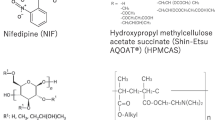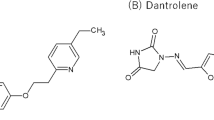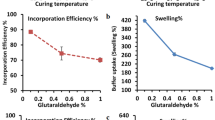Abstract
Purpose. Eudragit RL and RS 30D are pseudolatexes frequently used in the coating of solid dosage forms. They are based on cationic copolymers stabilized with quaternary ammonium groups (poly(ethylacrylate-methylmethacrylate-trimethylammonioethyl methacrylate chloride). A pH-independent drug release is expected because of the quaternary nature of the cationic groups. The objective was to explain a distinct “pH-dependent” drug release in various buffer media with coated diltiazem beads.
Methods. The diltiazem HC1 release from and water uptake of Eudragit RS/RL-coated beads was determined in various buffers of different buffer species, pH or concentration.
Results. The drug release in the different buffer media was in the following order: pH 5.0 acetate > pH 3.5 formate > pH 7.4 phosphate buffer > 0.1M HC1). This “pH-dependent” drug release could be explained with an anion exchange process; the chloride counterions of the quaternary groups were exchanged with the anionic buffer species during the dissolution study. The water uptake of the coated beads correlated well with the drug release from the beads. Increasing the buffer strength (acetate buffer) first increased and then decreased the drug release, while increasing the ionic strength of different buffers with NaCl decreased the drug release and eliminated the observed buffer effects because of the excess of chloride ions.
Conclusions. The anionic buffer species and not the pH had a significant effect on the hydration and hence on the drug release from beads coated with the cationic polymers, Eudragit RS and RL.
Similar content being viewed by others
REFERENCES
K. Lehmann and D. Dreher. Coating of tablets and small particles with acrylic resins by fluid bed technology. Int. J. Pharm. Tech. Prod. Mfr. 2:31–43 (1981).
K. Lehmann. The application and processing of acrylic coating in form of aqueous dispersions compared with organic solutions. Acta Pharm. Fenn. 91:225–238 (1982).
G.S. Banker and G.E. Peck. The new water-based colloidal dispersions. Pharm. Technol. 5(5):55–61 (1981).
K. Lehmann. Chemistry and application properties of polymethacrylate coating systems. In J.W. McGinity (ed.), Aqueous Polymeric Coatings for Pharmaceutical Applications, Marcel Dekker, New York, 1989, pp. 153–245.
Eudragit, Technical information. Röhm Pharma, Darmstadt, Germany.
X. Guo, R. Sarabia, P. Skultety, and R. Bodmeier. The effect of buffer species on hydration and mechanical properties of polymeric films prepared from aqueous colloidal cationic polymer dispersions. Polymer Preprints 34(1):633–634 (1993).
D. D. Perrin and B. Dempsey. Buffers for pH and metal ion control, Chapman and Hall, London, 1974.
G.A. McClelland, S. Sutton, K. Engle, and G.M. Zentner. The solubility-modulated osmotic pump: In vitro/in vivo release of diltiazem hydrochloride. Pharm. Res. 8:88–92 (1991).
R.S. Okor. Effect of polymer cation content on certain film properties. J. Pharm. Pharmacol. 34:83–86 (1982).
R. Kunin. Ion exchange resins, John Wiley & Sons, Inc., New York, 1958, pp. 320.
F. Helfferich. Ion Exchange, McGraw-Hill Book Co., New York, 1962, pp. 168.
Author information
Authors and Affiliations
Rights and permissions
About this article
Cite this article
Bodmeier, R., Guo, X., Sarabia, R.E. et al. The Influence of Buffer Species and Strength on Diltiazem HC1 Release from Beads Coated with the Aqueous Cationic Polymer Dispersions, Eudragit RS, RL 30D. Pharm Res 13, 52–56 (1996). https://doi.org/10.1023/A:1016021115481
Issue Date:
DOI: https://doi.org/10.1023/A:1016021115481




